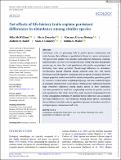Files in this item
Net effects of life-history traits explain persistent differences in abundance among similar species
Item metadata
| dc.contributor.author | McWilliam, Mike | |
| dc.contributor.author | Dornelas, Maria | |
| dc.contributor.author | Álvarez-Noriega, Mariana | |
| dc.contributor.author | Baird, Andrew H. | |
| dc.contributor.author | Connolly, Sean R. | |
| dc.contributor.author | Madin, Joshua S. | |
| dc.date.accessioned | 2022-11-24T12:30:14Z | |
| dc.date.available | 2022-11-24T12:30:14Z | |
| dc.date.issued | 2023-01-01 | |
| dc.identifier | 281182113 | |
| dc.identifier | 231f6352-5a78-4d38-b48b-28b87e60f721 | |
| dc.identifier | 85141373906 | |
| dc.identifier | 000877371900001 | |
| dc.identifier.citation | McWilliam , M , Dornelas , M , Álvarez-Noriega , M , Baird , A H , Connolly , S R & Madin , J S 2023 , ' Net effects of life-history traits explain persistent differences in abundance among similar species ' , Ecology , vol. 104 , no. 1 , e3863 . https://doi.org/10.1002/ecy.3863 | en |
| dc.identifier.issn | 0012-9658 | |
| dc.identifier.other | RIS: urn:3FECD168ABB65B050BC1A5F6278EA281 | |
| dc.identifier.uri | https://hdl.handle.net/10023/26481 | |
| dc.description | Funding: JSM and MM were supported by the National Science Foundation (NSF)1948946. MD is supported by the Warman Foundation, the Leverhulme Centre for Anthropocene Biodiversity (RC-2018-021) and NSF-NERC grant NE/V009338/1. MM is supported by a Leverhulme Trust Early Career Fellowship (ECF-2021-512). | en |
| dc.description.abstract | Life-history traits are promising tools to predict species commonness and rarity because they influence a population's fitness in a given environment. Yet, species with similar traits can have vastly different abundances, challenging the prospect of robust trait-based predictions. Using long-term demographic monitoring, we show that coral populations with similar morphological and life-history traits show persistent (decade-long) differences in abundance. Morphological groups predicted species positions along two, well-known life-history axes (the fast-slow continuum and size-specific fecundity). However, integral projection models revealed that density-independent population growth (λ) was more variable within morphological groups, and was consistently higher in dominant species relative to rare species. Within-group λ differences projected large abundance differences among similar species in short timeframes, and were generated by small but compounding variation in growth, survival, and reproduction. Our study shows that easily-measured morphological traits predict demographic strategies, yet small life-history differences can accumulate into large differences in λ and abundance among similar species. Quantifying the net effects of multiple traits on population dynamics is therefore essential to anticipate species commonness and rarity. | |
| dc.format.extent | 13 | |
| dc.format.extent | 1537401 | |
| dc.language.iso | eng | |
| dc.relation.ispartof | Ecology | en |
| dc.subject | Commonness | en |
| dc.subject | Rarity | en |
| dc.subject | Fitness | en |
| dc.subject | Comparative demography, trade-offs, reproduction | en |
| dc.subject | Recruitment | en |
| dc.subject | Functional traits | en |
| dc.subject | Coral reefs | en |
| dc.subject | Trade-offs | en |
| dc.subject | QL Zoology | en |
| dc.subject | DAS | en |
| dc.subject | MCC | en |
| dc.subject.lcc | QL | en |
| dc.title | Net effects of life-history traits explain persistent differences in abundance among similar species | en |
| dc.type | Journal article | en |
| dc.contributor.sponsor | The Leverhulme Trust | en |
| dc.contributor.sponsor | NERC | en |
| dc.contributor.institution | University of St Andrews. School of Biology | en |
| dc.contributor.institution | University of St Andrews. Centre for Biological Diversity | en |
| dc.contributor.institution | University of St Andrews. Fish Behaviour and Biodiversity Research Group | en |
| dc.contributor.institution | University of St Andrews. Marine Alliance for Science & Technology Scotland | en |
| dc.identifier.doi | https://doi.org/10.1002/ecy.3863 | |
| dc.description.status | Peer reviewed | en |
| dc.identifier.grantnumber | en | |
| dc.identifier.grantnumber | NE/V009338/1 | en |
This item appears in the following Collection(s)
Items in the St Andrews Research Repository are protected by copyright, with all rights reserved, unless otherwise indicated.

